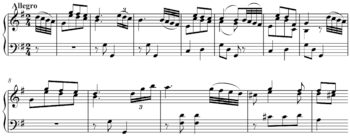Subject (music)

In music, a subject is the material, usually a recognizable melody, upon which part or all of a composition is based. In forms other than the fugue this may be known as the theme.
Characteristics
A subject may be perceivable as a complete musical expression in itself, separate from the work in which it is found (Drabkin 2001). In contrast to an idea or motif, a subject is usually a complete phrase or period (Dunsby 2002). The Encyclopédie Fasquelle defines a theme (subject) as "Any element, motif, or small musical piece that has given rise to some variation becomes thereby a theme" (Michel 1958–61).
Thematic changes and processes are often structurally important, and theorists such as Rudolph Reti have created analysis from a purely thematic perspective (Reti 1951; Reti 1967). Fred Lerdahl describes thematic relations as "associational" and thus outside his cognitive-based generative theory's scope of analysis (Lerdahl 2001, 5).
In different types of music
Music based on a single theme is called monothematic, while music based on several themes is called polythematic. Most fugues are monothematic and most pieces in sonata form are polythematic (Randel 2002, 429). In the exposition of a fugue, the principal theme (usually called the subject) is announced successively in each voice – sometimes in a transposed form.
In some compositions, a principal subject is announced and then a second melody, sometimes called a countersubject or secondary theme, may occur. When one of the sections in the exposition of a sonata-form movement consists of several themes or other material, defined by function and (usually) their tonality, rather than by melodic characteristics alone, the term theme group (or subject group) is sometimes used (Rushton 2001; Benward and Saker 2009, 136).
Music without subjects/themes, or without recognizable, repeating, and developing subjects/themes, is called athematic. Examples include the pre-twelve-tone or early atonal works of Arnold Schoenberg, Anton Webern, Alban Berg, and Alois Hába. Schoenberg once said that, "intoxicated by the enthusiasm of having freed music from the shackles of tonality, I had thought to find further liberty of expression. In fact, I … believed that now music could renounce motivic features and remain coherent and comprehensible nevertheless" (Schoenberg 1975, 88). Examples by Schoenberg include Erwartung. Examples in the works of later composers include Polyphonie X and Structures I by Pierre Boulez, Sonata for Two Pianos by Karel Goeyvaerts, and Punkte by Karlheinz Stockhausen (Grondines 2000).
Countersubject
In a fugue, when the first voice has completed the subject, and the second voice is playing the answer, the first voice usually continues by playing a new theme that is called the countersubject. The countersubject usually contrasts with the subject/answer phrase shape.
In a fugue, a countersubject is "the continuation of counterpoint in the voice that began with the subject", occurring against the answer (Benward and Saker 2009, 2:50). It is not usually regarded as an essential feature of fugue, however (Walker 2001).
The typical fugue opening resembles the following (Benward and Saker 2009, 2:50):
Soprano voice: Answer Alto voice: Subject Countersubject
Since a countersubject may be used both above and below the answer, countersubjects are usually invertible, all perfect fifths inverting to perfect fourths which required resolution (Benward and Saker 2009, 2:51).
See also
References
- Benward, Bruce, and Marilyn Nadine Saker (2009). Music in Theory and Practice, eighth edition, vol. 2. Boston: McGraw-Hill. ISBN 978-0-07-310188-0.
- Drabkin, William (2001). "Theme". The New Grove Dictionary of Music and Musicians, second edition, edited by Stanley Sadie and John Tyrrell. London: Macmillan Publishers.
- Dunsby, Jonathan (2002). "Theme". The Oxford Companion to Music, edited by Alison Latham. Oxford: Oxford University Press. ISBN 0-19-866212-2.
- Grondines, Pierre (2000). "Une nouvelle grammaire musicale: prémices et premiers essais" / "A New Musical Grammar: Principles and Early Experiments". La Scena Musicale 6, no. 3 (November).
- Lerdahl, Fred (1992)."Cognitive Constraints on Compositional Systems". Contemporary Music Review 6, no. 2:97–121.
- Lerdahl, Fred (2001). Tonal Pitch Space. Oxford and New York: Oxford University Press. ISBN 978-0-19-517829-6.
- Michel, François (ed). (1958–61). Encyclopédie de la musique, 3 vols. Paris: Fasquelle. (Cited in Nattiez 1990.)
- Nattiez, Jean-Jacques (1990). Music and Discourse: Toward a Semiology of Music, translated by Caroline Abbate [from Musicologie générale et sémiologie, 1987]. Princeton: Princeton University Press. ISBN 0-691-09136-6 (cloth); ISBN 0-691-02714-5.
- Randel, Don Michael (ed.) (1999). The Harvard Concise Dictionary of Music and Musicians. Cambridge, Mass.: Belknap Press. ISBN 0-674-00978-9.
- Reti, Rudolph (1951). The Thematic Process in Music. London: Faber and Faber; New York: Macmillan Co. Reprinted, London: Faber and Faber, 1961, Westport, CT: Greenwoid Press, 1978. ISBN 0-8371-9875-5.
- Reti, Rudolph (1967). Thematic Patterns in Sonatas of Beethoven, edited by Deryck Cooke. London: Faber and Faber; New York: Macmillan Co. Reprinted, New York: Da Capo Press, 1992. ISBN 0-306-79714-3.
- Rushton, Julia (2001). "Subject Group". The New Grove Dictionary of Music and Musicians, second edition, edited by Stanley Sadie and John Tyrrell. London: Macmillan Publishers.
- Schoenberg, Arnold (1975). "My Evolution". In Style and Idea: Selected Writings of Arnold Schoenberg, edited by Leonard Stein, translated by Leo Black, 88. London: Faber and Faber. ISBN 0-571-09722-7.
- Walker, Paul M. 2001. "Countersubject". The New Grove Dictionary of Music and Musicians, second edition, edited by Stanley Sadie and John Tyrrell. London: Macmillan Publishers.
